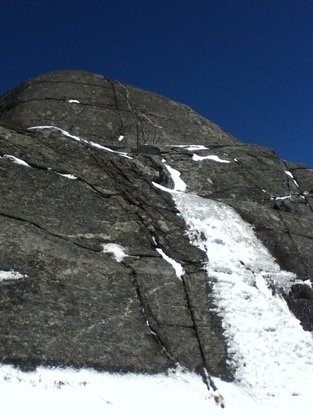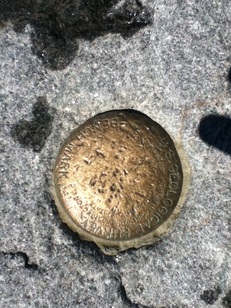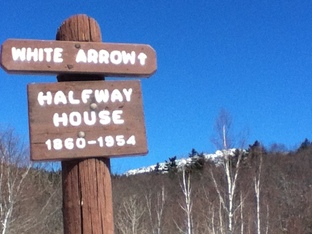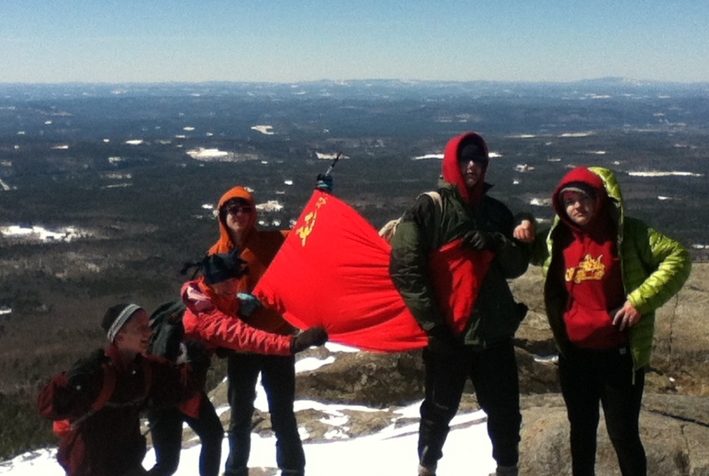
This month I start from the quiet, southwest side of Mount Monadnock. The trailhead is served by a circular driveway crammed with about 20 cars, and the ranger’s booth sits empty. So I pocket my fiver: free climb today. Ducking under the one-armed gate to the Old Toll Road, I get underway full of vim, vigor and old-time moxie, the air bracing on my cheeks, the sky dark-blue as the “dungarees” I wore as a child. A coming-down-the-mountain codger hails “Nice day!” “Perfect!” I respond, and moments later I divert onto the Old Halfway House Trail and meander through wintry woods.
The trail is packed snow, with the occasional boot-shaped hole running a couple feet deep. To my left lay the remnants of a stone wall, the former boundary between meadows that existed here between forest eras. Branches have fallen across these tumbled, snow-crusted rocks, making handy bridges for mice and chipmunks. I snap a photo because, well, I’m not sure why. It’s pretty, but lots of things are pretty. What are the criteria for framing, shooting, downloading and blog-posting vs. just walking by? Can’t I remember on my own?
A mile along, the trail is closed due to erosion and I veer back onto the Old Toll Road. Four middle-aged women pass by, laughing like crazy. What’s so funny? I almost ask. Maybe it’s a girl thing, maybe I don’t want to know, and at the end of the road I sweep powdery snow from a rock and sit down to tighten my shoelaces. The wind whistles faintly, or is that faraway traffic? Air through birch and maple groves, through iron pipes and cardboard filters…
Behind me, at 2,050 feet, there’s a large, stone house with “Keep Out” and “No Hunting or Fishing” signs guarding the driveway. Another sign closer to the private residence reads “The Hermitage” – like the museum in St. Petersburg or the asteroid discovered by the Russian astronomer Lyudmila Ivanova Chernykh (Wikipedia rocks!) or the hotel in Nashville where suffragettes in 1920 successfully lobbied the Tennessee legislature to pass the 19th Amendment, granting women the vote. According to monadnockmountain.com, The Hermitage began as a cabin built by Augustus Chamberlaine, the first hiker to write about the “roar of the mountain,” a thundering noise – like a wind tsunami – that graces the ears of Monadnock’s most faithful hikers. The mountain, perhaps, clearing its dungeon throat? Alas, I haven’t heard it – yet.
Decades ago, I wrote a comic screenplay about suffragettes at The Hermitage. The folks at HBO seemed to like it until one of their readers decided it was highly offensive, not to mention clichéd and sexist, that two characters employed their vaginas to change a pol’s vote.
The trail is packed snow, with the occasional boot-shaped hole running a couple feet deep. To my left lay the remnants of a stone wall, the former boundary between meadows that existed here between forest eras. Branches have fallen across these tumbled, snow-crusted rocks, making handy bridges for mice and chipmunks. I snap a photo because, well, I’m not sure why. It’s pretty, but lots of things are pretty. What are the criteria for framing, shooting, downloading and blog-posting vs. just walking by? Can’t I remember on my own?
A mile along, the trail is closed due to erosion and I veer back onto the Old Toll Road. Four middle-aged women pass by, laughing like crazy. What’s so funny? I almost ask. Maybe it’s a girl thing, maybe I don’t want to know, and at the end of the road I sweep powdery snow from a rock and sit down to tighten my shoelaces. The wind whistles faintly, or is that faraway traffic? Air through birch and maple groves, through iron pipes and cardboard filters…
Behind me, at 2,050 feet, there’s a large, stone house with “Keep Out” and “No Hunting or Fishing” signs guarding the driveway. Another sign closer to the private residence reads “The Hermitage” – like the museum in St. Petersburg or the asteroid discovered by the Russian astronomer Lyudmila Ivanova Chernykh (Wikipedia rocks!) or the hotel in Nashville where suffragettes in 1920 successfully lobbied the Tennessee legislature to pass the 19th Amendment, granting women the vote. According to monadnockmountain.com, The Hermitage began as a cabin built by Augustus Chamberlaine, the first hiker to write about the “roar of the mountain,” a thundering noise – like a wind tsunami – that graces the ears of Monadnock’s most faithful hikers. The mountain, perhaps, clearing its dungeon throat? Alas, I haven’t heard it – yet.
Decades ago, I wrote a comic screenplay about suffragettes at The Hermitage. The folks at HBO seemed to like it until one of their readers decided it was highly offensive, not to mention clichéd and sexist, that two characters employed their vaginas to change a pol’s vote.

Over the next rise, I tromp across the flat, treeless site of the Halfway House, an inn which operated on the mountain from 1860 until World War II; in 1954 it burned to the ground and not a shred of the building remains visible in any season. Many of the inn’s visitors arrived by horse-drawn carriage or motor car on the toll road; others walked several miles in from the train station. It’s said that Ulysses S. Grant and the boxer John L. Sullivan stayed there, as well as hordes of Bostonians seeking the cure of mountain air and marvelous views. J.S. Winter’s entertaining novel Murder on Mount Monadnock peoples the Halfway House with turn-of-the-century celebrity murder suspects, including Red Sox pitcher Smoky Joe Wood, randy young Franklin Roosevelt, vaudevillian Lillie Langtry and a young German who later became the World War I flying ace known as the “The Red Baron.”
Here, halfway to the peak, I take to the White Arrow Trail. Quickly it gets steep and icy, but the MICROspikes on my boots meet the challenge. I stop and chat with a hiker about the Halfway House and he makes an annoyed comment about the Hermitage and the guy who “owns the property.” He spits these last three words, as if poison; who, after all, dares claim grubby ownership of even a pine needle, a scrub beetle, a fleck of stone or lichen smear on a mountain as majestic, as G-d given as Monadnock? That, at least, is what I think he meant.
Soon after I run into a descending pair. He’s silent, sunken into himself – exhausted? meditating? – and she moves with a clomping gait, her curly hair staging a crazed escape from its woolen-hat prison. She bumps her pack against a half-capsized tree trunk and almost knocks herself over. What’s it like up there? I ask. “We didn’t summit today,” she responds – not today, so I peg them as regulars. Monadnock worshipers. Instead of summiting they hiked around the peak, a feat which calls for a good deal of bushwhacking. And down they keep going.
I grip and push up an ice-cramped slope – in summertime of olden days, pale professors and hoop-skirted ladies conquered this route with picnic baskets and metal water jugs – and emerge above tree line. Now it’s just “the last hard climb,” as the Halfway Housers called it. But first I stop near a giant rock that looks, if you squint, like a Mayan temple, and let’s say the ice-cascade bisecting the rock’s scarred face is the steps up the Temple of the Jaguar Priest at Tikal. From here the brown-white vistas are broken by shards of evergreen. A white ribbon runs to the southwest – perhaps an electric transmission-line alley cut through forest? Then I resume the climb, determined to make the top without stopping again.
Here, halfway to the peak, I take to the White Arrow Trail. Quickly it gets steep and icy, but the MICROspikes on my boots meet the challenge. I stop and chat with a hiker about the Halfway House and he makes an annoyed comment about the Hermitage and the guy who “owns the property.” He spits these last three words, as if poison; who, after all, dares claim grubby ownership of even a pine needle, a scrub beetle, a fleck of stone or lichen smear on a mountain as majestic, as G-d given as Monadnock? That, at least, is what I think he meant.
Soon after I run into a descending pair. He’s silent, sunken into himself – exhausted? meditating? – and she moves with a clomping gait, her curly hair staging a crazed escape from its woolen-hat prison. She bumps her pack against a half-capsized tree trunk and almost knocks herself over. What’s it like up there? I ask. “We didn’t summit today,” she responds – not today, so I peg them as regulars. Monadnock worshipers. Instead of summiting they hiked around the peak, a feat which calls for a good deal of bushwhacking. And down they keep going.
I grip and push up an ice-cramped slope – in summertime of olden days, pale professors and hoop-skirted ladies conquered this route with picnic baskets and metal water jugs – and emerge above tree line. Now it’s just “the last hard climb,” as the Halfway Housers called it. But first I stop near a giant rock that looks, if you squint, like a Mayan temple, and let’s say the ice-cascade bisecting the rock’s scarred face is the steps up the Temple of the Jaguar Priest at Tikal. From here the brown-white vistas are broken by shards of evergreen. A white ribbon runs to the southwest – perhaps an electric transmission-line alley cut through forest? Then I resume the climb, determined to make the top without stopping again.

Extra determined, actually, but not a minute later I experience an intense compulsion to turn around. There’s something behind you, my self tells me, something to see. No, I retort, too much stopping. Make tracks, not excuses. Grip, push off, step up, grip, push off – the feeling persists, however, gets stronger and I can’t resist. On a steep incline I set my feet sideways to the trail, anchor myself against a rocky crag, and turn.
And there it is, a lone hawk gliding the thermals. A brown double eyelash against the blue, she glides far out and away and then loops closer and closer, tracing the mountainside from east to west and north to south and down to up. All the while, it seems, she moves not a wing. Indeed, this crisscrossing hawk is Supreme Commander of Wind in total control of her destiny – no, even better, she’s Mistress of Grateful Surrender to the Fates. Actually I’m not sure which designation is more apt or if there’s even a difference in the end. Ten minutes later I force myself to blink hard and get to the summit.
And what do I find there? A full-sized flag of the Union of Soviet Socialist Republics flying from a hiking pole planted between boulders. I blink hard again. I stare at the yellow hammer and sickle on totalitarian red. What in the freaking world? Mind-flash: Krushchev pounding his shoe at the UN, duck-and-cover drills at Lloyd H. Bugbee Elementary School, the Miracle on Ice, Soviet tanks rumbling across Hungary, Sputnik, five-year plans, Ludmilla Tourisheva nails the landing, Soviet Life magazine dangling on its library stick at Sedgwick Junior High School, MAD, my social-studies report on the nuclear triad, McCarthy hearings, John le Carre thrillers, fluoridated water, pimply-backed East German lady swimmers grabbing steroid-gold, Brezhnev’s eyebrows, shortwave Radio Moscow informing little Hal that angry American Negroes are rioting everywhere, the Red Scare, Red Menace, Red Scourge, Red Dawn…
Jesus H. Christ, the Russians are Finally Coming! Or Putin, that KGB rascal, he’s rebuilt the old empire and the invasion starts right here, right now, on the freezing heights of Mount Monadnock where all creation can be surveyed…
Or it’s a bunch of kids messing around. After tapping my hiking pole on the summit’s U.S. Geological Survey benchmark plaque, as per tradition, I seek them out. Five knuckleheads huddle near the symbol of our once implacable enemy. They’re teens of some sort.
And there it is, a lone hawk gliding the thermals. A brown double eyelash against the blue, she glides far out and away and then loops closer and closer, tracing the mountainside from east to west and north to south and down to up. All the while, it seems, she moves not a wing. Indeed, this crisscrossing hawk is Supreme Commander of Wind in total control of her destiny – no, even better, she’s Mistress of Grateful Surrender to the Fates. Actually I’m not sure which designation is more apt or if there’s even a difference in the end. Ten minutes later I force myself to blink hard and get to the summit.
And what do I find there? A full-sized flag of the Union of Soviet Socialist Republics flying from a hiking pole planted between boulders. I blink hard again. I stare at the yellow hammer and sickle on totalitarian red. What in the freaking world? Mind-flash: Krushchev pounding his shoe at the UN, duck-and-cover drills at Lloyd H. Bugbee Elementary School, the Miracle on Ice, Soviet tanks rumbling across Hungary, Sputnik, five-year plans, Ludmilla Tourisheva nails the landing, Soviet Life magazine dangling on its library stick at Sedgwick Junior High School, MAD, my social-studies report on the nuclear triad, McCarthy hearings, John le Carre thrillers, fluoridated water, pimply-backed East German lady swimmers grabbing steroid-gold, Brezhnev’s eyebrows, shortwave Radio Moscow informing little Hal that angry American Negroes are rioting everywhere, the Red Scare, Red Menace, Red Scourge, Red Dawn…
Jesus H. Christ, the Russians are Finally Coming! Or Putin, that KGB rascal, he’s rebuilt the old empire and the invasion starts right here, right now, on the freezing heights of Mount Monadnock where all creation can be surveyed…
Or it’s a bunch of kids messing around. After tapping my hiking pole on the summit’s U.S. Geological Survey benchmark plaque, as per tradition, I seek them out. Five knuckleheads huddle near the symbol of our once implacable enemy. They’re teens of some sort.
“What’s with the flag?” I ask, trying not to sound judgmental.
“Nothing,” one says. She wears a court jester’s hat made of black fleece.
“So, are you guys Russian?”
“No,” a few respond.
“Are you communists?”
“No, no,” is their chorus, mixed with rapid side comments that escape into the wind-whipped air. Do these young ones know about the Soviet Gulag? About Gary Powers and the U-2 incident? The Domino Theory, the Cuban Missile Crisis? What about Yuri Gagurin, refusniks, glasnost, perestroika, Gorbachev and Reagan at Reykjavik, the Berlin Wall? Do they have nightmares of nuclear apocalypse, as I did as a child? I’d sleepwalk to the living room and cover myself with the giant, purple cushions from our scimitar-shaped sectional sofa. In the morning my mother would find me beneath the slabs and she’d raise me from my sleep death and bundle me off to the kitchen for a glass of Tang and a poached egg on toast. Maybe canned hash, if I was lucky. While she cooked, I’d check the baseball box scores in The Hartford Courant.
“Are you anarchists?”
A slight pause. Then: “Yes, yes!” They cry out, laughing, “Yes, we’re anarchists!”
I chat with one boy who explains that they’re also high school sophomores – born, some of them, in this very century! – from Brookline, Massachusetts.
“Ah,” I say. “So the flag is ironic.”
“Semi-ironic,” another boy corrects me.
The girl with the jester hat explains that she found the flag in her grandfather’s basement and doesn’t know why it’s there or how it connects to the old man You should ask him, I almost say but don’t because this is the bald, rocky head of Monadnock in spring-going-on-winter and we’re all good up here, all fellow voyagers. The Brooklinites buzz about like child-bees and I wonder if gramps was a CCCP sympathizer. Or crazed cold warrior. Maybe he traded a Stars and Stripes for that flag at the Elbe River, spring of 1945, when Soviet and American armies converged. Maybe he’s a Jew who fought in the Red Army against Hitler. Maybe he’s a former social studies teacher. Or picked up the flag at a yard sale. Or all of the above.
“Nothing,” one says. She wears a court jester’s hat made of black fleece.
“So, are you guys Russian?”
“No,” a few respond.
“Are you communists?”
“No, no,” is their chorus, mixed with rapid side comments that escape into the wind-whipped air. Do these young ones know about the Soviet Gulag? About Gary Powers and the U-2 incident? The Domino Theory, the Cuban Missile Crisis? What about Yuri Gagurin, refusniks, glasnost, perestroika, Gorbachev and Reagan at Reykjavik, the Berlin Wall? Do they have nightmares of nuclear apocalypse, as I did as a child? I’d sleepwalk to the living room and cover myself with the giant, purple cushions from our scimitar-shaped sectional sofa. In the morning my mother would find me beneath the slabs and she’d raise me from my sleep death and bundle me off to the kitchen for a glass of Tang and a poached egg on toast. Maybe canned hash, if I was lucky. While she cooked, I’d check the baseball box scores in The Hartford Courant.
“Are you anarchists?”
A slight pause. Then: “Yes, yes!” They cry out, laughing, “Yes, we’re anarchists!”
I chat with one boy who explains that they’re also high school sophomores – born, some of them, in this very century! – from Brookline, Massachusetts.
“Ah,” I say. “So the flag is ironic.”
“Semi-ironic,” another boy corrects me.
The girl with the jester hat explains that she found the flag in her grandfather’s basement and doesn’t know why it’s there or how it connects to the old man You should ask him, I almost say but don’t because this is the bald, rocky head of Monadnock in spring-going-on-winter and we’re all good up here, all fellow voyagers. The Brooklinites buzz about like child-bees and I wonder if gramps was a CCCP sympathizer. Or crazed cold warrior. Maybe he traded a Stars and Stripes for that flag at the Elbe River, spring of 1945, when Soviet and American armies converged. Maybe he’s a Jew who fought in the Red Army against Hitler. Maybe he’s a former social studies teacher. Or picked up the flag at a yard sale. Or all of the above.

I say goodbye to these Generation Z kids – a New York Times article says they’re independent, globally oriented, diverse in heritage and shaped by the post-9/11 world – and climb down to tree line to eat lunch on an outcropping as the cold, afternoon sun slides along the southern sky. The hawk doesn’t return, but three older teens arrive and I hear them arguing. One insists that they shouldn’t continue to the summit, that they don’t have the right equipment and it’s too icy, too dangerous. Someone could get hurt. Another young man asserts that he drove all this way and hiked for hours and sure as hell doesn’t want to stop now. The third boy stays quiet. I eat my PB&J sandwich and tell myself to butt out. Not my business. Don’t.
“Hey,” I yell to the teens. “You gotta go up top! It’s awesome, the view is amazing. And it’s not far – ten minutes, easy.”
“You see?” says the gung-ho fella to his friends.
I swivel and swing out my boots, draped in MICROspikes. “Look, I have to admit that I’ve got the gear,” I say. “But you’re young, so we’re even.”
They murmur, confer, and decide to go for it. But first, lunch, and the teens dive into their packs for soda and bags of chips. They eat standing up, staring at the peak. I gather myself and head down the trail, wishing them luck and hoping the cautious kid doesn’t shatter his femur because of my shaming pep talk. As I descend it gets warmer, almost balmy, and I unzip my coat. There’s a granular mushiness to the snow. Is the world finally beginning to melt? To forget the tricks of freezing? Yes, winter’s a bit long in the tooth on this late March day, a little too settled in its ways. Unaware, perhaps, of the green torrent to come.
Then a teenager stripped to his t-shirt appears, churning uphill with a banana held in his bare hand like an ice pick. It bears repeating: they’ve got youth, I’ve got the gear, we’re even.
I cross the meadow where the Halfway House once glowed by the buttery light of kerosene lamps, where nature’s ardent lovers paused for a night’s sleep or furtive bouts of fornication before the morning ascent and a delightful luncheon at the peak. It must have been a grand scene in those days, but I’m glad the inn’s gone, and its ghosts, too. No one should own anything on the mountain and nothing built here should remain.
Pack out what you pack in.
“Hey,” I yell to the teens. “You gotta go up top! It’s awesome, the view is amazing. And it’s not far – ten minutes, easy.”
“You see?” says the gung-ho fella to his friends.
I swivel and swing out my boots, draped in MICROspikes. “Look, I have to admit that I’ve got the gear,” I say. “But you’re young, so we’re even.”
They murmur, confer, and decide to go for it. But first, lunch, and the teens dive into their packs for soda and bags of chips. They eat standing up, staring at the peak. I gather myself and head down the trail, wishing them luck and hoping the cautious kid doesn’t shatter his femur because of my shaming pep talk. As I descend it gets warmer, almost balmy, and I unzip my coat. There’s a granular mushiness to the snow. Is the world finally beginning to melt? To forget the tricks of freezing? Yes, winter’s a bit long in the tooth on this late March day, a little too settled in its ways. Unaware, perhaps, of the green torrent to come.
Then a teenager stripped to his t-shirt appears, churning uphill with a banana held in his bare hand like an ice pick. It bears repeating: they’ve got youth, I’ve got the gear, we’re even.
I cross the meadow where the Halfway House once glowed by the buttery light of kerosene lamps, where nature’s ardent lovers paused for a night’s sleep or furtive bouts of fornication before the morning ascent and a delightful luncheon at the peak. It must have been a grand scene in those days, but I’m glad the inn’s gone, and its ghosts, too. No one should own anything on the mountain and nothing built here should remain.
Pack out what you pack in.

 RSS Feed
RSS Feed